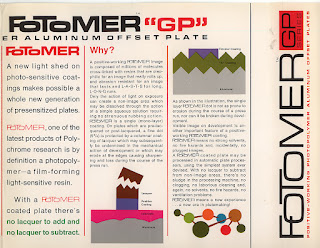In late 1950, Fuji Photo Film of Japan visited Polychrome to obtain offset plate technology license. Offset printing in Japan was in its infancy. Dr. Oba,, then in charge of new business development, saw the potential and over objection of Fuji R&D made arrangement with Polychrome, saying being the first in Japan is sure way to become No 1 in Japan. He was right, Fuji was ahead of competition in Japan and dominated the Japanese market and eventually the world. In the beginning, however, they met difficulty as the GAP plate we had, essentially an "additive" plate was not received well there. They wanted positive plate like Kalle's "subtractive" type plate.
Mr. Kobayashi, one of Fuji's technician, studied Kalle patents and found a loophole and came up with a plate similar to Kalle's. Since Polychorme's license stipulated reciprocity, we received free use of the technology and patent. Then Fuji was only focused on Japanese market, they applied for its American and European patents only after our urging and assistance. Dr. Delos Bown then head of R&D in Yonkers took charge of synthesizing the compound and I assisted in quality control and coating of the first Polychrome positive coating. Polychrome then did not have a solvent coating machine. The only solvent coater was in Speidel, a subsidiary in Philadelphia specializing diazo coating. The first ever Polychrome subtractive positive was coated in Speidel at 2m/min and an one thousand feet coated aluminum roll was put in my Volkswagen bug (seat removed) to be brought back to Yonkers to be finished and sent to Drupa 1968 where it received a lot of attention. Our German facility was suffering from the lack of Kalle compatible plate and this fit the bill. Despite of the digital revolution, this conventional positive coating is still widely used around the world by Polychrome and Polychrome affiliates. One could argue that this plate actually built foundation of Polychrome Europe.
Ken S. .



